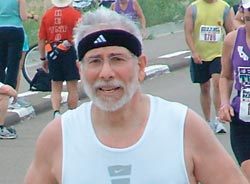
Even super-fit athletes, like marathoner Glenn Scimonelli (above), can benefit from CAM treatment for conditions such as low back pain.
Photo courtesy of Glenn Scimonelli
"Oh, my aching back," is an all-too-familiar complaint.
Low back pain is one of our most common medical problems. At least one-quarter of all U.S. adults suffer from it every year. It's also the number two reason for visiting the doctor, as Glenn Scimonelli can attest.
"My problems are chronic," says the 22-time marathoner. He used to find relief in running but may have to cut back because of the way he feels. To ease his lower back, he has used conventional and complementary and alternative medicine (CAM) approaches, including regular visits to the chiropractor and massage therapist to address his pain. "I'm looking for something so that I don't have to feel like I'm walking on eggshells," says Scimonelli.

A chiropractor practices spinal manipulation on a patient.
Photo: NCCAM
Pat Wilkerson, a certified massage therapist in Columbia, Maryland, says "Many of my clients use massage therapy in conjunction with other alternative and traditional therapies to help them resume normal activity and reduce discomfort."
According to the 2007 National Health Interview Survey, back pain and related conditions are the top reasons adults use CAM. Research on CAM therapies for low back pain suggest that:
- Spinal manipulation can provide mild-to-moderate relief. It appears to be as effective as conventional treatments.
- Acupuncture is more effective than sham or no treatment in relieving pain and improving function. It is an effective complement to conventional treatments.
- A 2008 review of 13 clinical trials found evidence that massage might be useful for low back pain.
- Yoga is more effective than a self-care book for improving function and reducing pain. The benefits persist for at least several months.
Recently, the American College of Physicians and the American Pain Society said these CAM therapies can serve as options for chronic back pain that does not improve with self-care.
